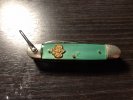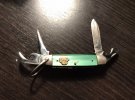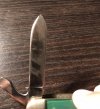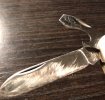Affix a sheet of wet/dry sandpaper to a hard & flat surface, like glass, stone or wood. Lay the blade flat against the sandpaper with the plunge grind (forward edge of the ricasso/tang) flush against the edge of the hard backing surface, and make edge-trailing (spine-leading) passes, making sure to keep the blade moving in straight, one-direction-only passes. As DM mentioned above, starting with something like ~220 should produce some visible change pretty fast. Then, for a fully-polished finish, do the same again in a sequence of finer grits, like 320 > 400 > 600 > 800 > 1200/1500 > 2000. Make sure to completely erase each stage of grit scratches with the following grit, before stepping forward to the next grit. You don't want to get far up in the sequence, only to start seeing very coarse, deep scratches that weren't fully removed earlier. After the 2000-grit, follow that with the Flitz polish.
If you don't want to go to all that trouble for the full polish, just doing the same with the 220 or 320 alone will leave a nice 'satin' finish on the blade, which emulates a lot of factory finishes on knife blades. Doing it that way is very easy and won't take long on simple carbon or low-alloy stainless blades (yours looks like stainless), especially smaller ones. And over time, that'd also make it easier to take it a step or three up in finish, a little bit at a time, if you still want to do that.




